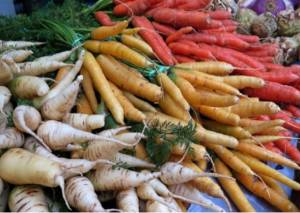Gemüseanbau im Seebezirk (Murten) gestern und heute
Description
Cultivation of vegetables arose from small family farms. Small scale vegetable cultivation here has a long history. Poverty was the rule here into the middle 19th century. Especially women obtained extra food with vegetables. In comparison to the communities of the "Moos" the communities around Murten were still privileged. They were at higher elevations and less swampy, while in the Moos hay, pastures and "Lische" were the only goods, the border communities had still usable brown mineralized soil for the hilltop vegetable cultivation. In Vully as well, where the mild lakeshore climate allowed vegetable cultivation as an "insurance" for wine. Already in the 18th century female farmers from the region went to the markets of Berne, Neuenburg or Will. Legend has it that Friburgers were allowed to sell onions in the market of Bern. As reward for their help in the Bern city fire and armed assistance during the Burgundy wars. But only with the first Juragewässerkorrektion (1868-1891) did the vegetable cultivation reach large scales in the Seebezirk, at first at the edge of the Gossen Mooses in the so-called Moosgärten, later in part of the Vormooses, which are still privately owned. Women were the first to recognize the potential of the black earth soils left after drying. That was no surprise since they already had long experience with vegetables in gardens and plantations. The farmers first had to learn how to cultivate an acid, dry soil. First prototypical farms were located in Witzwil and Bellechasse and later in the Swiss Cooperative for Vegetables. There it was discovered that the newly obtained soil needs potassium and phosphorus to grow plants. And it took about half a century before economically usable yields were obtained. In Kerzers it was the parson, which in 1900 started to grow asparagus in sandy soils. Later he also borrowed land, but having two jobs as farmer and parson exceeded his abilities and the whole deal ended badly. However, his intitiative led in 1898 to the construction of the first canning industry. Aside from peas and beans asparagus was cultivated as well. Peas and beans were harvested by hand, the subsequent processing of beans was also done by hand (at the farmers' homes). To avoid anyone from taking some beans for their own use, they were weighted. In 1899 the first sugar factory had been opened in Aarberg. This created another source of revenue for farmers. Sugar beets were harvested by hand for years. During both world wars vegetable farming prospered, in part as compensation for lost imports. In the mid 1950s a new canning factory was opened.
The sale of fresh vegetables at first was entirely the business of women at markets. They transported baskets and boxes to the railway stations every friday and monday evening in a small cart, into the 1950s. The railway shipped the goods overnight to the urban markets. The women followed in the early morning train. At this time the first vegetable salesmen were on the move. They bought the goods directly from the farmers and resold them into large scale commerce or directly to hotels, restaurants and vegetable shops. The cargo was still transported in boxes or baskets then.
Vegetable farming at that time was done almost entirely by hand. The entire Family, servants and day laborer helped. When the first simple machines were developed, it became easier to pull salads, carrots, radish and onions into rows. The Seebezirk however was never solely about vegetable farming. A farm was a mixed Operation. In the late 1950s the Grossen Moos became swampy. The dehydrated soils had collapsed. As part of the second Juragewässerkorrektion this made it necessary to merge properties and the construction of modern drainage systems, which turned the shapeless small vegetable fields (so-called Hosenträger) into larger fields. At the end water is pumped from the lower terrain into the canals, like in Holland.
Over time modern techniques were established. Tractors made mechanization possible, the fields grew in size. But modern pesticides also contributed. Less workers were needed. Thus over time the largest vegetable farm of Switzerland came into existence. Peasants first became vegetable farmers, later vegetable gardeners, entepreneurs and specialists. In the new millennium, the pressure to rationalize forced more mergers. Pre-packaging became the rule, pre-harvesters, robots, photocells, colour detection, and computer programs, appeared on fields. Hand work was no longer needed. The times of market women, the side jobs of vegetable farming in small and tiny operations were over. The mechanization had caused massive changes and was highly capital intense. Grow or go away is the formula of the present-day vegetable agriculture. Only a handful of factories sell their products themselves, be it in their own shops or the weekly markets in Bern, Freiburg or Murten. A couple of family farms still plant asparagus, which they sell in the local gastronomy. Many vegetable farmers gave up at the Generation change, others grew to large companies with many foreign personnel, or they merged into operative communities.








